The Content of Heavy Metals in Cigarettes and the Impact of Their Leachates on the Aquatic Ecosystem
Abstract
1. Introduction
2. Materials and Methods
2.1. Sampling of Cigarettes
- Unsmoked cigarette (USC): The cigarettes were cut, without smoking, at a third of the way up the cigarette using a sterile scissor, and the remaining portion (including tobacco and butt) was sampled as USC.
- Smoked Cigarette (SC): Cigarettes were smoked artificially until half of the cigarette (1/3 from the top) was sampled as SC.
- Unsmoked Butt (USB): The cigarette’s filter (butt) was cut and removed before being sampled as USB.
- Smoked Butt (SB): Cigarettes were smoked artificially until the butt was exposed and sampled as SB.
2.2. Smoking of Cigarettes
2.3. Preparation of Leachates
2.4. Heavy Metal Analysis in Cigarette Samples
2.5. Acid Digestion of Cigarette Leachates
2.6. Statistical Analysis
3. Results
3.1. Content of Heavy Metals in the Different Samples of Expensive Brand
3.2. Levels of Heavy Metals in Different Samples of a Moderate Brand
3.3. Levels of Heavy Metals in the Different Samples of Cheap Brand
3.4. Levels of Heavy Metals in the Leachates of Different Samples of an Expensive Brand
3.5. Levels of Heavy Metals in the Leachates of Different Samples of the Moderate Brand
3.6. Levels of Heavy Metals in the Leachates of Different Samples of the Cheaper Brand
4. Discussion
5. Conclusions
Author Contributions
Funding
Institutional Review Board Statement
Informed Consent Statement
Data Availability Statement
Acknowledgments
Conflicts of Interest
References
- Habre, R.; Coull, B.; Moshier, E.; Godbold, J.; Grunin, A.; Nath, A.; Castro, W.; Schachter, N.; Rohr, A.; Kattan, M.; et al. Sources of indoor air pollution in New York City residences of asthmatic children. J. Expo. Sci. Environ. Epidemiol. 2014, 24, 269–278. [Google Scholar] [CrossRef]
- Robinson, D.L. Air pollution in Australia: Review of costs, sources and potential solutions. Health Promot. J. Aust. 2005, 16, 213–220. [Google Scholar] [CrossRef] [PubMed]
- Mohajerani, A.; Kadir, A.A.; Larobina, L. A Practical proposal for solving the world’s cigarette butt problem: Recycling in fired clay bricks. Waste Manag. 2016, 52, 228–244. [Google Scholar] [CrossRef]
- El Tokhi, M.; Amin, B.M.; Alaabed, S.A. Environmental Assessment of Heavy Metals Contamination of Bottom Sediments of Oman Gulf, United Arab Emirates. J. Pollut. Eff. Control 2017, 5, 203. [Google Scholar] [CrossRef]
- Slaughter, E.; Gersberg, R.M.; Watanabe, K.; Rudolph, J.; Stransky, C.; Novotny, T.E. Toxicity of cigarette butts, and their chemical components, to marine and freshwater fish. Tob. Control 2011, 20 (Suppl. 1), i25–i29. [Google Scholar] [CrossRef] [PubMed]
- Micevska, T.; Warne, M.S.J.; Pablo, F.; Patra, R. Variation in, and causes of toxicity of cigarette butts to a cladoceran and microtox. Arch. Environ. Contam. Toxicol. 2006, 50, 205–212. [Google Scholar] [CrossRef] [PubMed]
- Moriwaki, H.; Kitajima, S.; Katahira, K. Waste on the roadside, ‘poi-sute’waste: Its distribution and elution potential of pollutants into environment. Waste Manag. 2009, 29, 1192–1197. [Google Scholar] [CrossRef] [PubMed]
- Talhout, R.; Schulz, T.; Florek, E.; Van Benthem, J.; Wester, P.; Opperhuizen, A. Hazardous compounds in tobacco smoke. Int. J. Environ. Res. Public Health 2011, 8, 613–628. [Google Scholar] [CrossRef] [PubMed]
- Register, K. Cigarette butts as litter-toxic as well as ugly. Underw. Nat. 2000, 25, 23–29. [Google Scholar]
- Ministry of Agriculture, Food and Rural Affairs. Policy Analysis Branch. Survey of Pesticide Use in Ontario, 1993: Estimates of Pesticides Used on Field Crops, Fruit and Vegetable Crops, Provincial Highway Roadsides, and by Licensed Pesticide Applicators; Policy Analysis Branch, Ontario Ministry of Agriculture, Food and Rural Affairs: Guelph, ON, Canada, 1994.
- Baker, R.R.; da Silva, J.R.P.; Smith, G. The effect of tobacco ingredients on smoke chemistry. Part I: Flavourings and additives. Food Chem. Toxicol. 2004, 42, 3–37. [Google Scholar] [CrossRef]
- Baker, R.R.; da Silva, J.R.P.; Smith, G. The effect of tobacco ingredients on smoke chemistry. Part II: Casing ingredients. Food Chem. Toxicol. 2004, 42, 39–52. [Google Scholar] [CrossRef] [PubMed]
- Mussalo-Rauhamaa, H.; Salmela, S.S.; Leppänen, A.; Pyysalo, H. Cigarettes as a source of some trace and heavy metals and pesticides in man. Arch. Environ. Health 1986, 41, 49–55. [Google Scholar] [CrossRef] [PubMed]
- Iskander, F. Egyptian and foreign cigarettes: I. Determination of trace elements in cigarette filter before and after smoking. J. Radioanal. Nucl. Chem. 1985, 91, 191–196. [Google Scholar] [CrossRef]
- Iskander, F. Egyptian and foreign cigarettes: II. Determination of trace elements in tobacco, ash and wrapping paper. J. Radio Anal. Nucl. Chem. 1986, 97, 107–112. [Google Scholar] [CrossRef]
- Owens, W.F. Effect of cigarette paper on smoke yield and composition. Recent Adv. Tob. Sci. 1978, 4, 3–24. [Google Scholar]
- Novotny, T.E.; Lum, K.; Smith, E.; Wang, V.; Barnes, R. Cigarettes butts and the case for an environmental policy on hazardous cigarette waste. Int. J. Environ. Res. Public Health 2009, 6, 1691–1705. [Google Scholar] [CrossRef]
- Novotny, T.E.; Hardin, S.N.; Hovda, L.R.; Novotny, D.J.; McLean, M.K.; Khan, S. Tobacco and cigarette butt consumption in humans and animals. Tob. Control 2011, 20 (Suppl. 1), i17–i20. [Google Scholar] [CrossRef]
- Kokila, R.; Balasubramanian, B.; Meenambigai, K.; Alagirisamy, K.; Kumar, A.; Kamyab, H.; Nareshkumar, A. A GIS-based tool for the analysis of the distribution and abundance of Chilo sacchariphagus indicus under the influence of biotic and abiotic factors. Environ. Technol. Innov. 2021, 21, 101357. [Google Scholar] [CrossRef]
- Priya, A.; Anusha, G.; Thanigaivel, S.; Karthick, A.; Mohanavel, V.; Velmurugan, P.; Balasubramanian, B.; Ravichandran, M.; Kamyab, H.; Kirpichnikova, I.M.; et al. Removing microplastics from wastewater using leading-edge treatment technologies: A solution to microplastic pollution—A review. Bioprocess Biosyst. Eng. 2022, 1–13. [Google Scholar] [CrossRef]
- Dobaradaran, S.; Nabipour, I.; Saeedi, R.; Ostovar, A.; Khorsand, M.; Khajeahmadi, N.; Hayati, R.; Keshtkar, M. Association of metals (Cd, Fe, As, Ni, Cu, Zn and Mn) with cigarette butts in northern part of the Persian Gulf. Tob. Control 2017, 26, 461–463. [Google Scholar] [CrossRef]
- Mindell, J. Lessons from tobacco control for advocates of healthy transport. J. Public Health 2001, 23, 91–97. [Google Scholar] [CrossRef] [PubMed][Green Version]
- Chiba, M.; Masironi, R. Toxic and trace elements in tobacco and tobacco smoke. Bull. World Health Organ. 1992, 70, 269. [Google Scholar] [PubMed]
- Savino, J.F.; Tanabe, L.L. Sublethal effects of phenanthrene, nicotine, and pinane on Daphnia pulex. Bull. Environ. Contam. Toxicol. 1989, 42, 778–784. [Google Scholar] [CrossRef] [PubMed]
- Eneji, I.S.; Salawu, O.W.; Sha’Ato, R. Analysis of heavy metals in selected cigarettes and tobacco leaves in Benue State, Nigeria. World J. Med. Med. Sci. Res. 2013, 1, 33–37. [Google Scholar]
- Matsunaga, K.; Konishi, S.; Nishimura, M. Possible errors caused prior to measurement of mercury in natural waters with special reference to seawater. Environ. Sci. Technol. 1979, 13, 63–65. [Google Scholar] [CrossRef]
- Janaydeh, M.; Ismail, A.; Zulkifli, S.Z.; Omar, H. Toxic heavy metal (Pb and Cd) content in tobacco cigarette brands in Selangor state, Peninsular Malaysia. Environ. Monit. Assess. 2019, 191, 637. [Google Scholar] [CrossRef]
- Engida, A.M.; Chandravanshi, B.S. Assessment of heavy metals in tobacco of cigarettes commonly sold in Ethiopia. Chem. Int. 2017, 3, 212–218. [Google Scholar]
- Sebiawu, G.E.; Mensah, N.J.; Ayiah-Mensah, F. Analysis of heavy metals content of tobacco and cigarettes sold in Wa Municipality of Upper West Region, Ghana. Chem. Process Eng. Res. 2014, 25, 24–33. [Google Scholar]
- Kazi, T.G.; Jalbani, N.; Arain, M.B.; Jamali, M.K.; Afridi, H.I.; Shah, A.Q. Determination of toxic elements in different brands of cigarette by atomic absorption spectrometry using ultrasonic assisted acid digestion. Environ. Monit. Assess. 2009, 154, 155–167. [Google Scholar] [CrossRef]
- Ashraf, M.W. Levels of heavy metals in popular cigarette brands and exposure to these metals via smoking. Sci. World J. 2012, 2012, 729430. [Google Scholar] [CrossRef]
- Raju, N.J.; Kofod, M.; Isenbeck-Schröter, M.; Müller, G. Heavy metal content of Indian cigarettes. Toxicol. Environ. Chem. 1999, 72, 215–219. [Google Scholar] [CrossRef]
- Phal, D.A. A comparative study of elemental analysis in mosquito repellent coil and cigarette smoke. Int. J. Pharm. Biol. Sci. 2011, 1, 462–467. [Google Scholar]
- Kowalski, R.; Wierciński, J. Mercury content in smoke and tobacco from selected cigarette brands. Ecol. Chem. Eng. S 2009, 16, 155–162. [Google Scholar]
- Zulfiqar, S.; Shabbir, S.; Ishaq, M.; Shaukat, M.S.; Sarwar, M.I. Metal distribution in Pakistani and foreign brands of cigarette ash. Bull. Environ. Contam. Toxicol. 2006, 77, 679–686. [Google Scholar] [CrossRef]
- Akhbarizadeh, R.; Dobaradaran, S.; Parhizgar, G.; Schmidt, T.C.; Mallaki, R. Potentially toxic elements leachates from cigarette butts into different types of water: A threat for aquatic environments and ecosystems? Environ. Res. 2021, 202, 111706. [Google Scholar] [CrossRef]
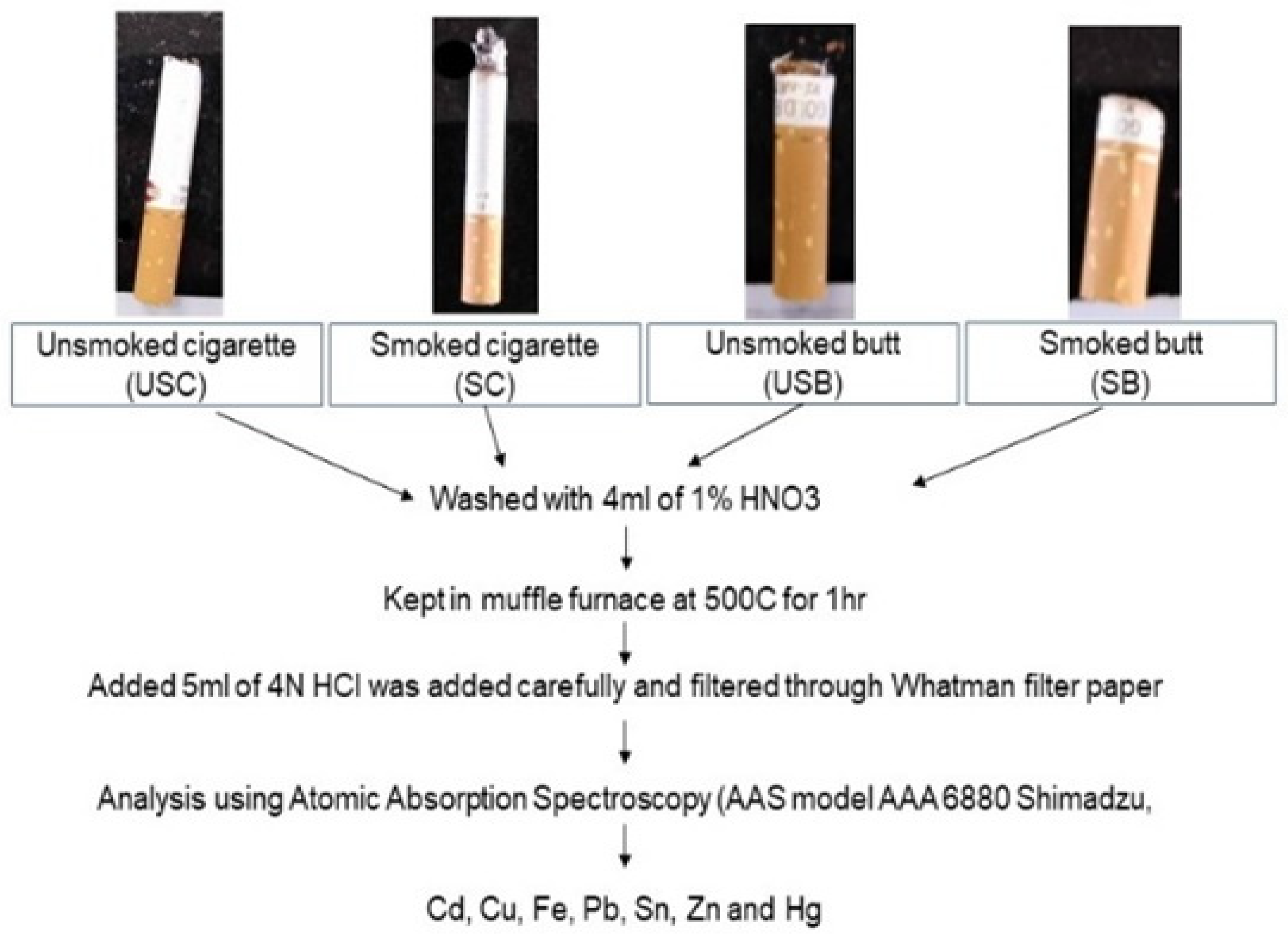

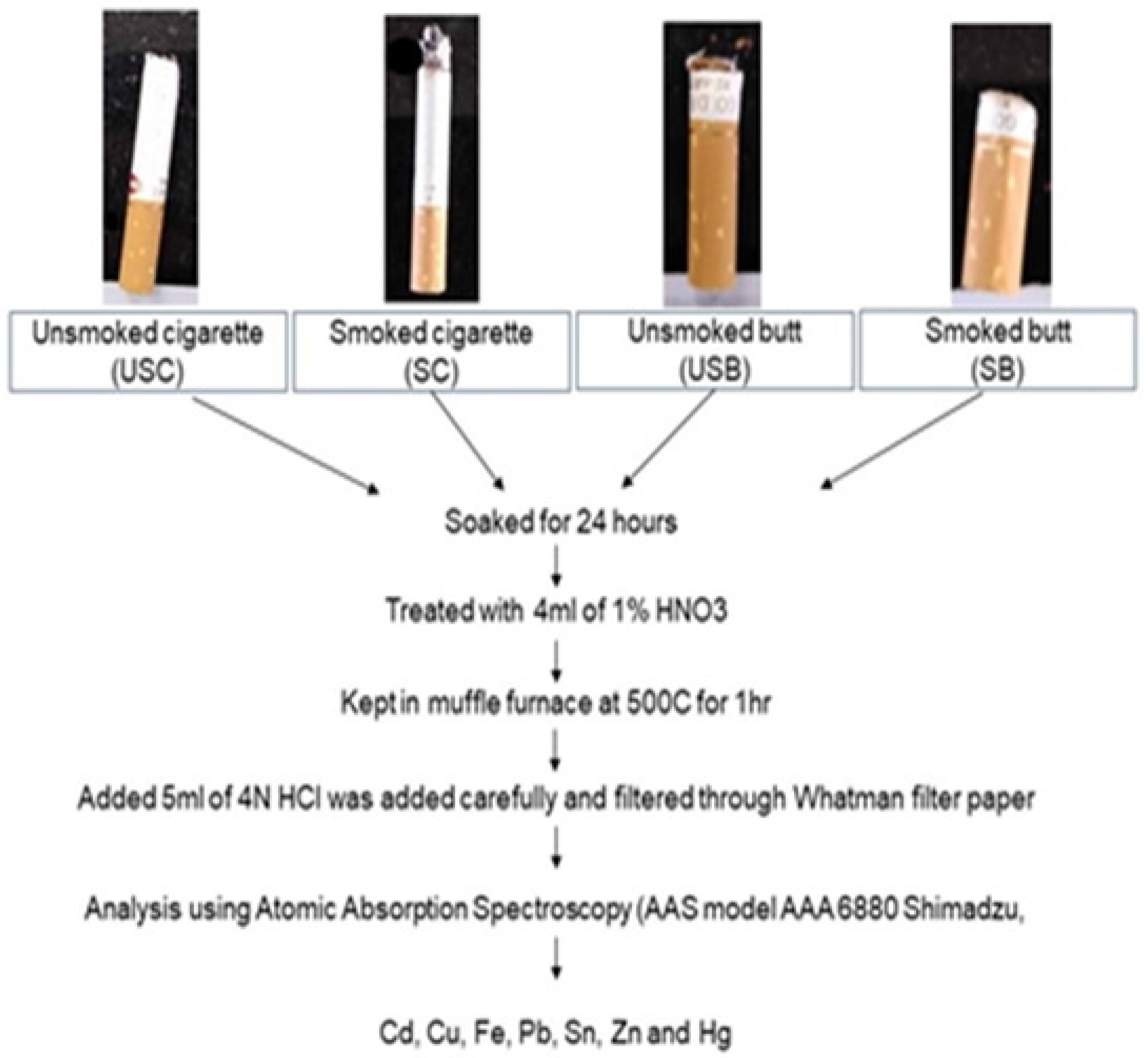
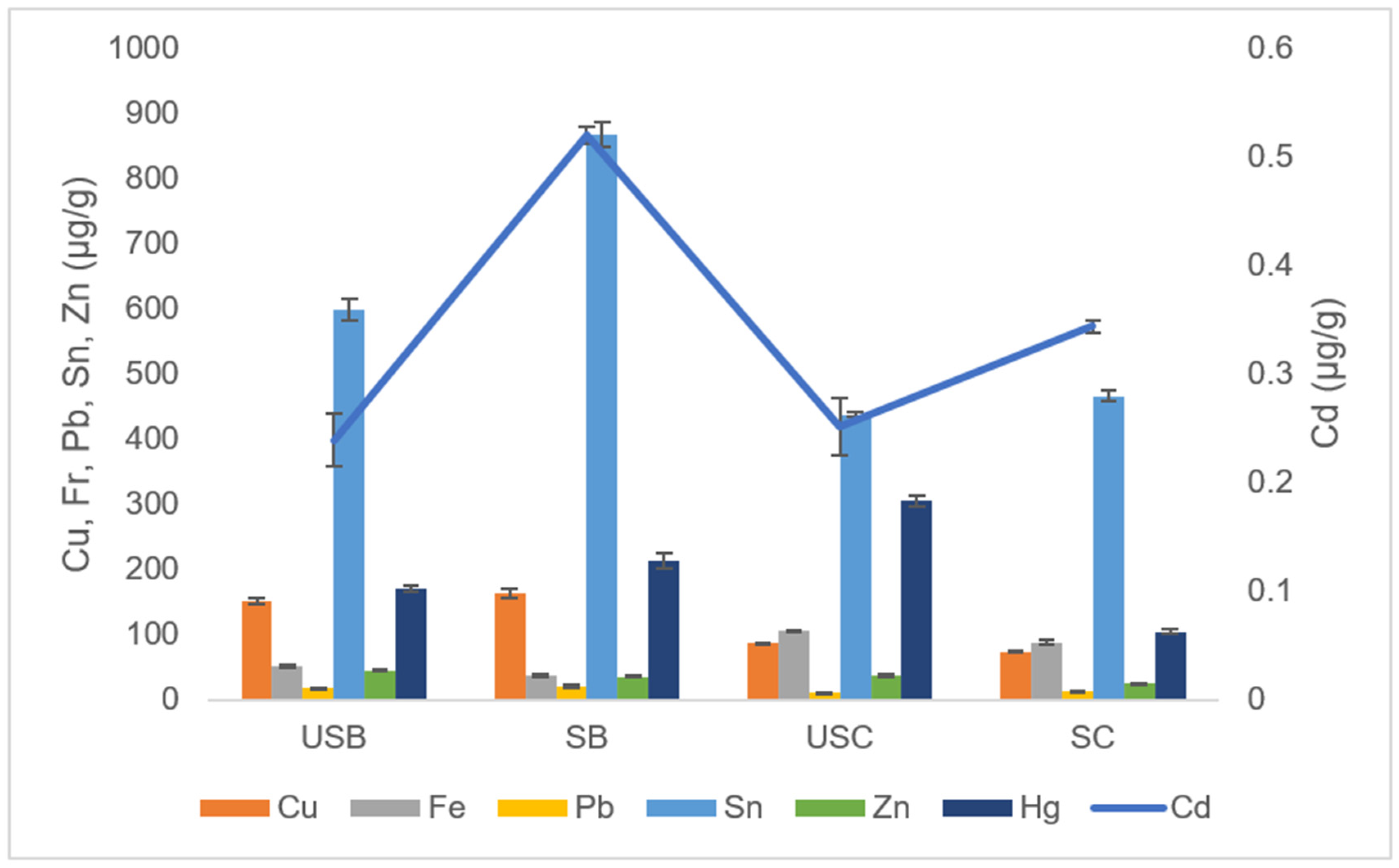
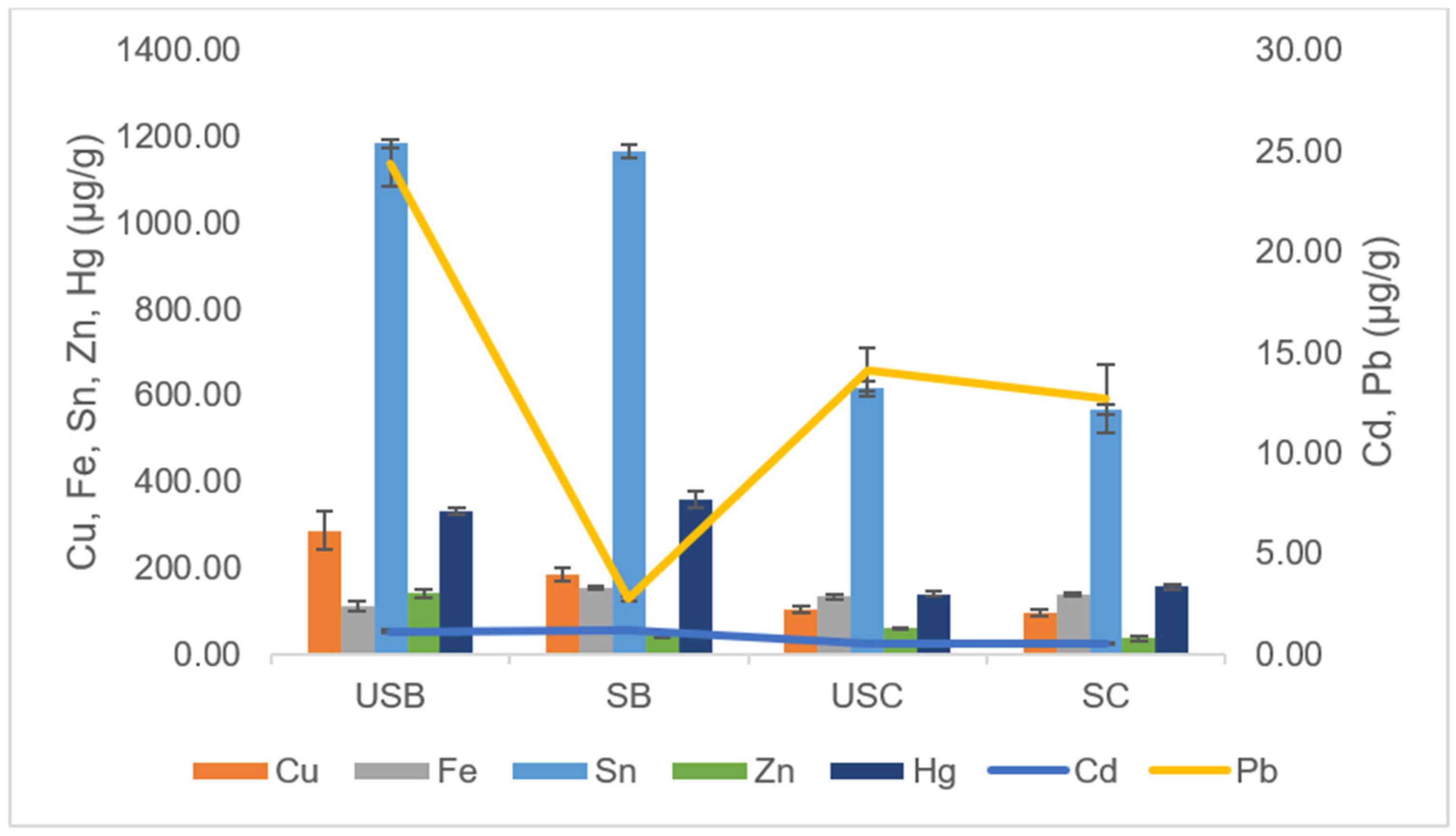
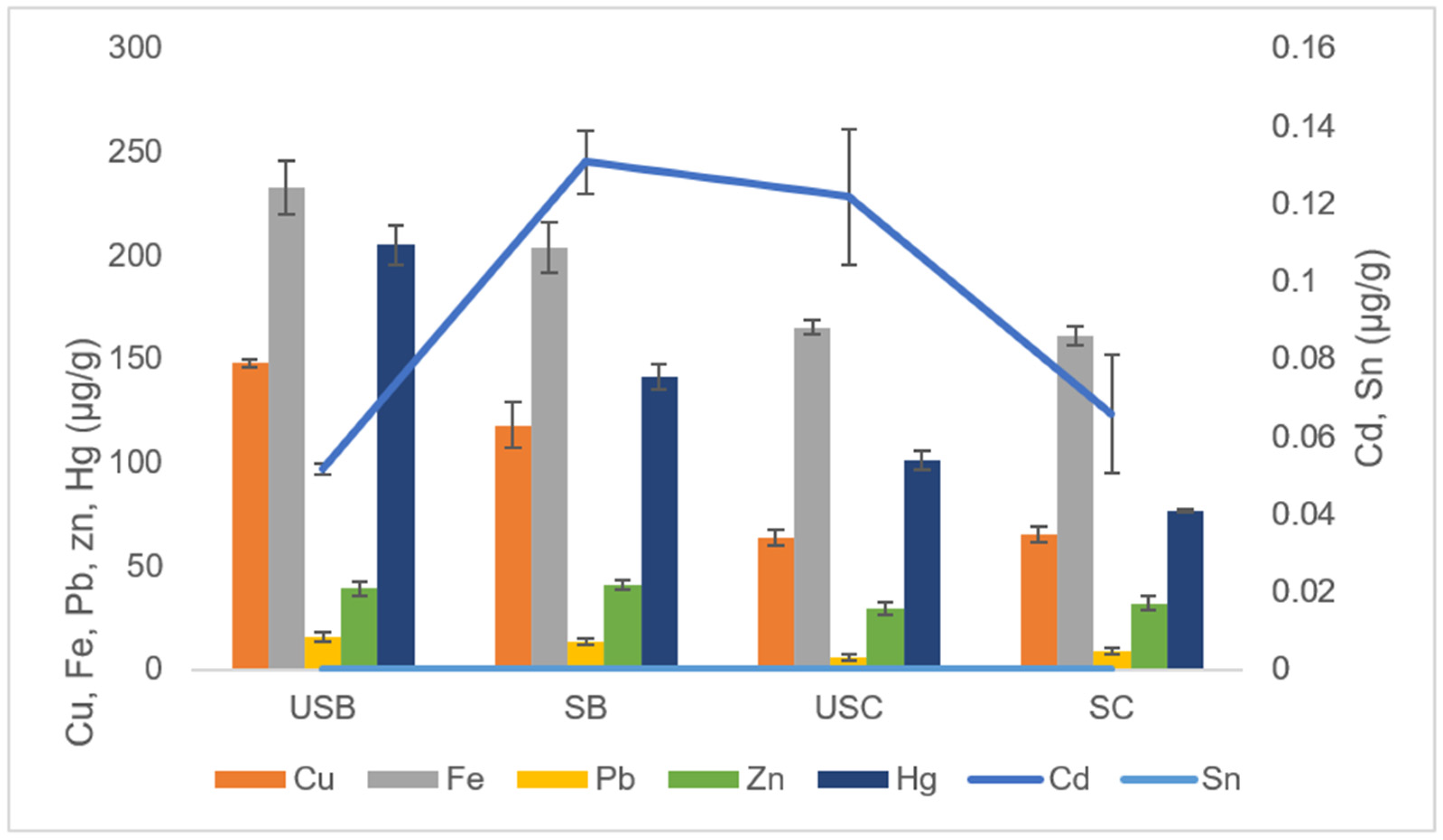

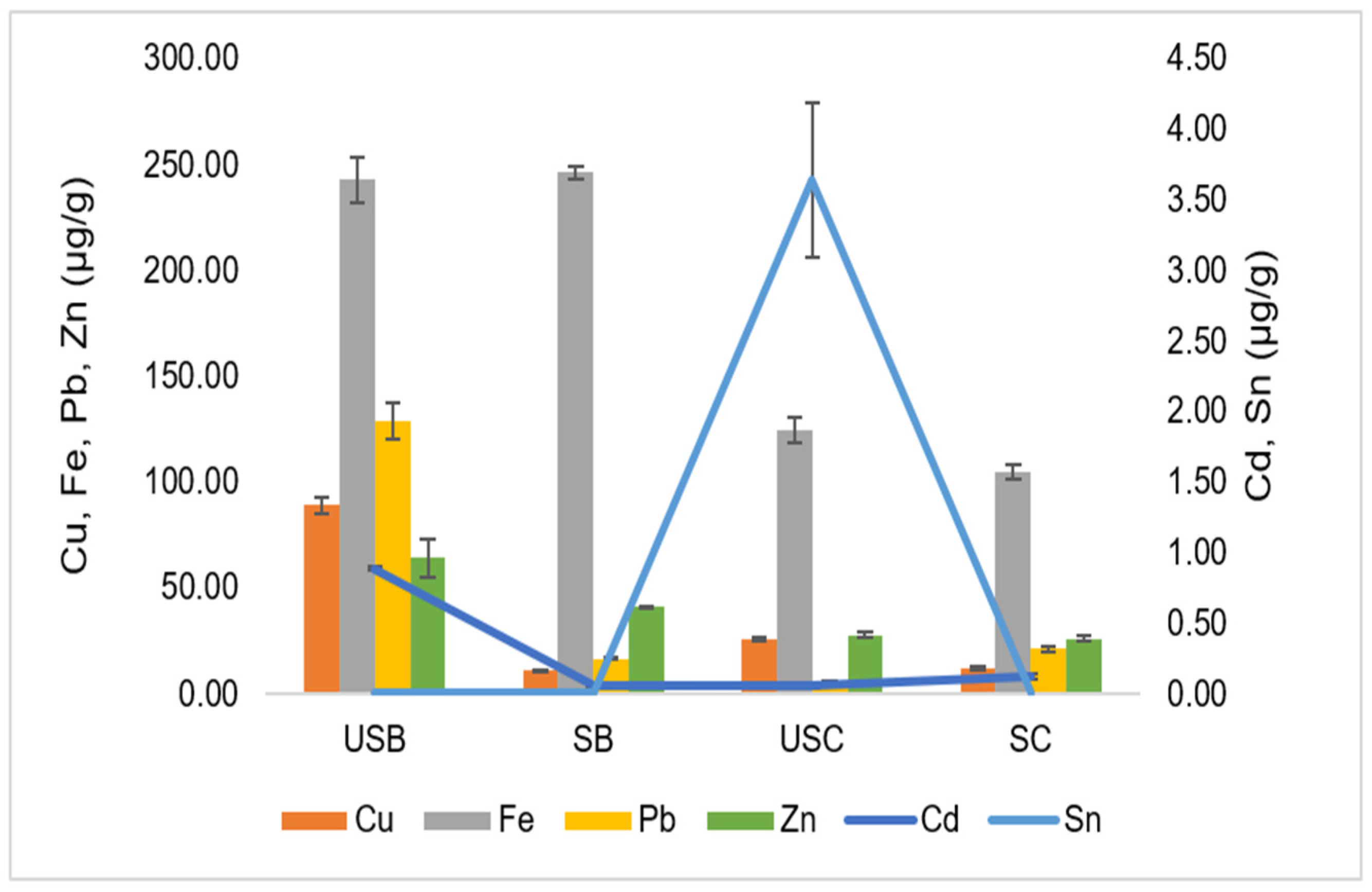
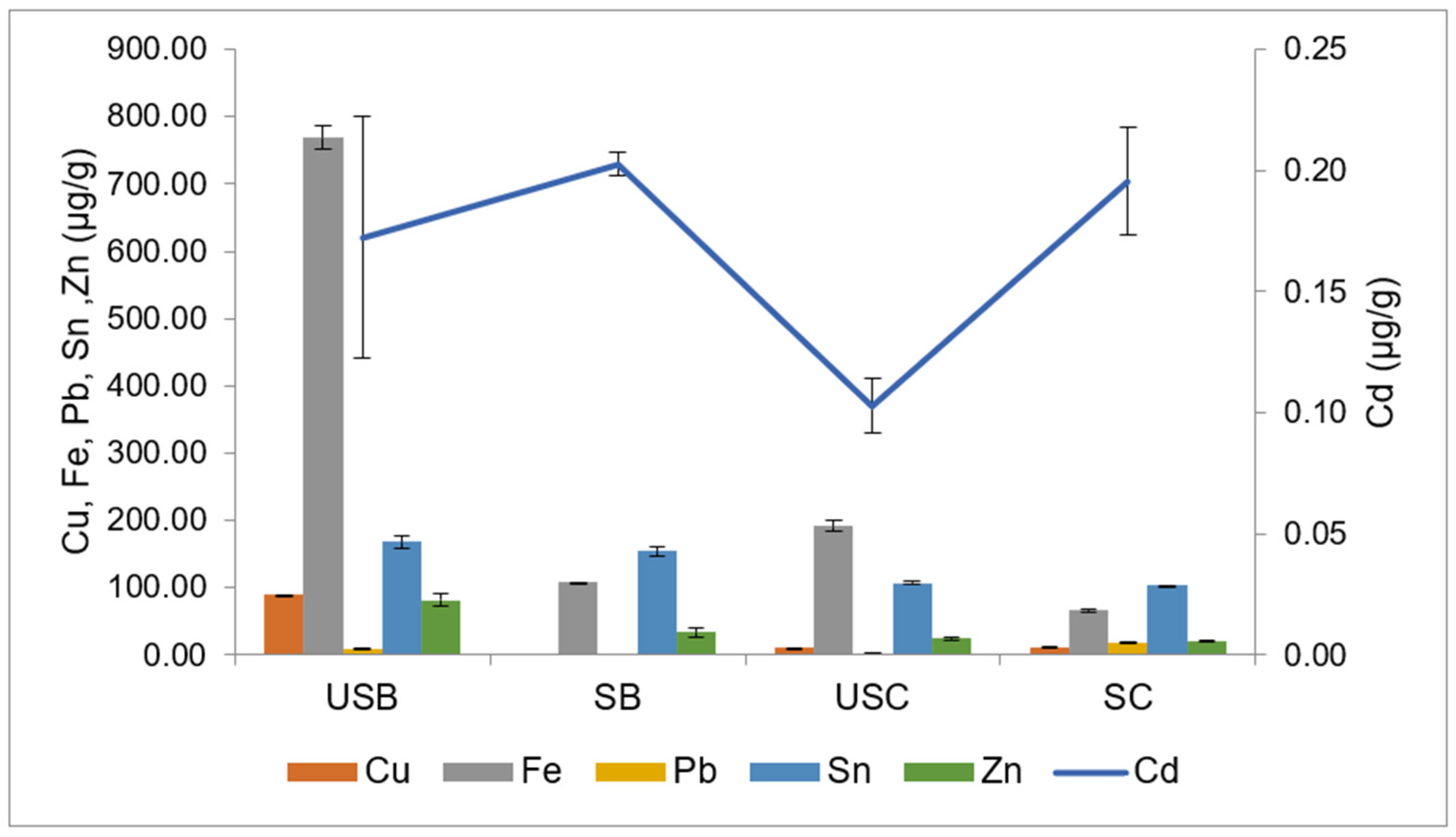
Publisher’s Note: MDPI stays neutral with regard to jurisdictional claims in published maps and institutional affiliations. |
© 2022 by the authors. Licensee MDPI, Basel, Switzerland. This article is an open access article distributed under the terms and conditions of the Creative Commons Attribution (CC BY) license (https://creativecommons.org/licenses/by/4.0/).
Share and Cite
Michael, M.; Meyyazhagan, A.; Velayudhannair, K.; Pappuswamy, M.; Maria, A.; Xavier, V.; Balasubramanian, B.; Baskaran, R.; Kamyab, H.; Vasseghian, Y.; et al. The Content of Heavy Metals in Cigarettes and the Impact of Their Leachates on the Aquatic Ecosystem. Sustainability 2022, 14, 4752. https://doi.org/10.3390/su14084752
Michael M, Meyyazhagan A, Velayudhannair K, Pappuswamy M, Maria A, Xavier V, Balasubramanian B, Baskaran R, Kamyab H, Vasseghian Y, et al. The Content of Heavy Metals in Cigarettes and the Impact of Their Leachates on the Aquatic Ecosystem. Sustainability. 2022; 14(8):4752. https://doi.org/10.3390/su14084752
Chicago/Turabian StyleMichael, Maria, Arun Meyyazhagan, Krishnakumar Velayudhannair, Manikantan Pappuswamy, Anu Maria, Vincent Xavier, Balamuralikrishnan Balasubramanian, Rathinasamy Baskaran, Hesam Kamyab, Yasser Vasseghian, and et al. 2022. "The Content of Heavy Metals in Cigarettes and the Impact of Their Leachates on the Aquatic Ecosystem" Sustainability 14, no. 8: 4752. https://doi.org/10.3390/su14084752
APA StyleMichael, M., Meyyazhagan, A., Velayudhannair, K., Pappuswamy, M., Maria, A., Xavier, V., Balasubramanian, B., Baskaran, R., Kamyab, H., Vasseghian, Y., Chelliapan, S., Safa, M., Moradi, Z., & Khadimallah, M. A. (2022). The Content of Heavy Metals in Cigarettes and the Impact of Their Leachates on the Aquatic Ecosystem. Sustainability, 14(8), 4752. https://doi.org/10.3390/su14084752









